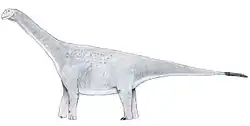| Ledumahadi Temporal range: Hettangian-Sinemurian, | |
|---|---|
 | |
| Restoration of Ledumahadi mafube | |
| Scientific classification | |
| Domain: | Eukaryota |
| Kingdom: | Animalia |
| Phylum: | Chordata |
| Clade: | Dinosauria |
| Clade: | Saurischia |
| Clade: | †Sauropodomorpha |
| Clade: | †Sauropoda |
| Clade: | †Lessemsauridae |
| Genus: | †Ledumahadi McPhee et al., 2018 |
| Type species | |
| †Ledumahadi mafube McPhee et al., 2018 | |
Ledumahadi (meaning "giant thunderclap" in Sesotho language) is a genus of lessemsaurid sauropodomorph dinosaur from the Early Jurassic Elliot Formation in Free State Province, South Africa.[1] The type and only species is L. mafube,[1][2] known from a singular incomplete postcranial specimen. A quadruped, it was one of the first giant sauropodomorphs, reaching a weight of around 12 tonnes (13 short tons), despite not having evolved columnar limbs like its later huge relatives.[1]
Description
Ledumahadi was likely a quadruped, as determined by analysis of the circumference of its humerus and femur compared to those of other dinosaurs. It would have had very large, robust forelimbs, consistent with those of its relatives. Unlike those of later sauropods, these limbs were naturally flexed, as opposed to being purely columnar.[1][3]
Size

At its time in the Early Jurassic epoch, Ledumahadi is thought to have been the largest land animal that had ever lived.[1] At the age of 14 years, L. mafube is estimated to have reached a maximum size of around 12 tonnes (13 short tons) in body mass, significantly larger than its relatives. L. mafube was more comparable to the later sauropod Diplodocus in body mass.[1][3] An ichnotaxon named Tetrasauropus belongs to a sauropodomorph that is estimated to have a hip height of 2 m (6.6 ft), meaning that it likely belongs to Ledumahadi.[4]
Classification
A phylogenetic analysis of Ledumahadi mafube was performed by McPhee and colleagues, which found it to belong to a recently recognised clade of sauropodiformes called Lessemsauridae, including the closely related South African Antetonitrus and Lessemsaurus from Argentina. Another lessemsaurid described in 2018, Ingentia, could not be included in their analysis but was also recognised as belonging to Lessemsauridae. The results of McPhee and colleagues' analysis are shown in the cladogram below:[1][3]
| Sauropodiformes |
| ||||||||||||||||||||||||||||||||||||||||||||||||||||||||||||||||||||||||||||||
The size of the taxon was deemed to be important in the wider picture of sauropodomorph evolution, similar to its other lessemsaurid relatives. Living only a few million years after the Triassic-Jurassic extinction event, it indicates that this event must have either had only a small effect on body size within the sauropodomorph lineage, or may have not affected it at all. Significance was also found in the magnitude of the size itself—it lacked the columnar limbs that characterized its more derived relatives, thought to be a key adaptation in body size evolution. Ornithischian dinosaurs reach their largest sizes around a similar size of 12 to 17 tonnes in weight. This may have been the upper limit for dinosaurs without adopting the characteristics found in true sauropods, which grew to be several times the weight of Ledumahadi.[1][3]
See also
References
- 1 2 3 4 5 6 7 8 McPhee, Blair W.; Benson, Roger B.J.; Botha-Brink, Jennifer; Bordy, Emese M. & Choiniere, Jonah N. (2018). "A giant dinosaur from the earliest Jurassic of South Africa and the transition to quadrupedality in early sauropodomorphs". Current Biology. 28 (19): 3143–3151.e7. doi:10.1016/j.cub.2018.07.063. PMID 30270189.
- ↑ "†Ledumahadi McPhee et al. 2018". Paleobiology Database. Fossilworks. Retrieved 17 December 2021.
- 1 2 3 4 Apaldetti, Cecilia; Martínez, Ricardo N.; Cerda, Ignatio A.; Pol, Diego & Alcober, Oscar (2018). "An early trend towards gigantism in Triassic sauropodomorph dinosaurs". Nature Ecology & Evolution. 2 (8): 1227–1232. doi:10.1038/s41559-018-0599-y. hdl:11336/89332. PMID 29988169.
- ↑ Sander, P.M.; Lallensack, J.N. (2018). "Dinosaurs: Four Legs Good, Two Legs Bad". Current Biology. 28 (19): R1160–R1163. doi:10.1016/j.cub.2018.08.025.










